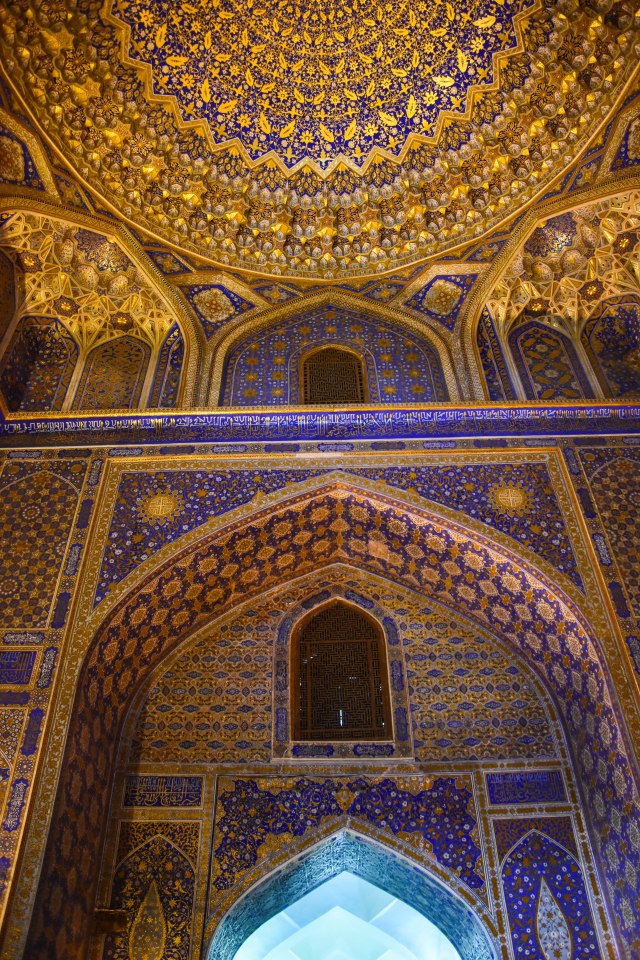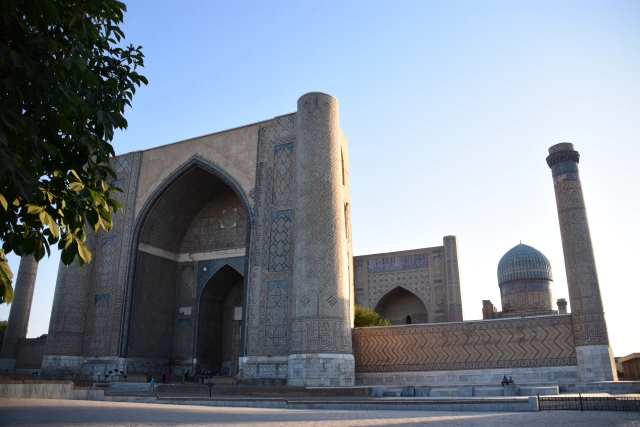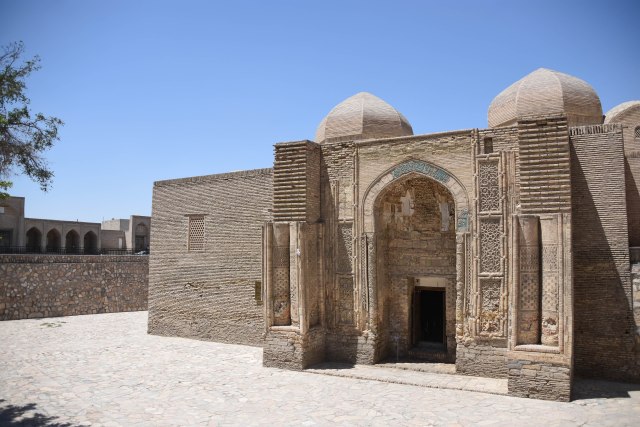Exotic Uzbekistan is fast becoming a must-see destination for intrepid travellers wanting to get off the beaten path.
The Central Asian country is located on what was known as the Silk Road – an ancient trade route extending from Iran to China.
Because of this, Uzbekistan features some of the most beautiful buildings I’ve ever seen covered in mosaic tiles decorated in rich patterns of blue, green, white, gold and rose.
Uzbekistan recently introduced an e-visa, making it easier than ever for travellers to visit this fascinating country.
Read on to find out what you need to know before travelling to Uzbekistan independently.
Where is Uzbekistan?
Uzbekistan is one of two double landlocked countries in the world (the other is Liechtenstein). It’s sandwiched in between Kazakhstan, Turkmenistan, Tajikistan and Kyrgyzstan.
Still don’t know where it is? It’s south of Russia and west of China and was once part of the USSR until it gained independence in 1991.
Getting to Uzbekistan can be a little tricky. From Europe, many airlines flying into Uzbekistan’s capital Tashkent go via Moscow (Russia), Istanbul (Turkey) or Astana (Kazakhstan). From the USA, many airlines fly through Seoul (South Korea).
You can also reach Uzbekistan by land. Some people enter Uzbekistan from Iran by obtaining a transit visa through Turkmenistan. You can also reach Uzbekistan by land from Kyrgyzstan and Tajikistan.

When To Go
High season is April to May and August to September and this is the best time to go. In July, Uzbekistan experiences a prolonged heatwave of 40+ degree Celsius temperatures. While you won’t see many tourists, the heat is intense at this time of year. Trust me, I made the mistake of visiting in July and I wouldn’t do it again!
Visas
Most nationalities need a visa to enter Uzbekistan. It’s now easier than ever to get a visa with an e-visa system recently introduced replacing the need to apply in advance at an Uzbekistan embassy.
You can find a comprehensive guide on the e-visa on Caravanistan here.
Accommodation
Backpacking is fairly new to Uzbekistan and the hostel scene is still developing. There is a growing number of hostels in the main cities of Tashkent, Samarkand, Bukhara and Khiva. I recommend Tashkent’s Art Hostel, Amir Hostel in Samarkand and Lali-opa Hostel in Khiva.
For travellers with a bigger budget, there are also many hotels and guesthouses on offer.
All travellers must be registered at an accommodation provider at least every three nights during your stay in Uzbekistan. When you check out, your accommodation will provide you with a registration card. Keep these with your passport and you may be asked for them when you leave the country.
Money
You may have heard about the black market for money in Uzbekistan. This has now been abolished and you can now exchange money in banks for the rate of the day.
The local currency is called Soum. Coins are rare and you’ll end up with a huge stash of cash and feel like a millionaire. Bills come in 200, 500, 1000, 5000, 10000 and 50000. You’ll find your 1000 and 10000 bills to be the most useful.
$1 USD is roughly equal to 7000 Soum.
You probably won’t be able to fit your wad of cash in your wallet, so bring a zippered pouch or similar to hold your money.
It’s best to bring in US Dollars to exchange as you will lose less in the exchange compared to Euros. It’s important that your bills are crisp and unmarked. No folds, tears, or marks. I had the experience of many of my bills being rejected because they were creased or had pen marks on them.

Money can only be exchanged in banks (there are no exchange offices) or your accommodation may be able to exchange your cash as well.
You will need Soum for supermarket purchases, to buy train and bus tickets, and take a shared taxi ride.
Accommodation providers will accept US Dollars.
It may be possible to withdraw money from ATMs but do not rely on them. If you arrive in Uzbekistan on a weekend, ATMs are likely to be out of money.
I had no luck with bank ATMs. All of the ones I tried did not work. The ATMs in hotels were the most reliable and I was able to withdraw $50 USD bills from Hotel Asia in Bukhara.
Getting Around
There are a variety of different ways to get around Uzbekistan and it depends on your budget and desired level of comfort.
It’s possible to get around by train, shared taxi, bus or marshrutka. You can also fly between the major cities to and from Tashkent.
Train is an excellent way to get between Tashkent, Samarkand and Bukhara. But be aware that all the train stations are located several kilometres from the centre and you will need to bargain for a taxi on arrival.
In some cities, a shared taxi is the most efficient way to get around. It’s recommended to get from Bukhara-Khiva, Khiva-Urgench and Urgench-Nukus by shared taxi.
It’s possible to bargain on the price for shared taxis. Taxis will only leave when they are full (4 people). Plan to travel early in the day, especially when the weather is hot.
Domestic flights are available to and from Tashkent on the national airline Uzbekistan Airways. Airports are located in Nukus, Urgench and Bukhara. You can buy tickets online via Skyscanner.

Scams
The only scam I encountered during my two weeks in Uzbekistan was by taxi drivers. Taxi drivers, especially at airports, preyed on tourists in the hope they didn’t know what the real price. For example, at Tashkent Airport, taxi drivers start out quoting $10 USD for the 5km drive but will quickly drop to $5. The real price should be no more than $3 USD (or about 20,000 Soum).
Do your research so you know approximately what the price would be and be prepared to bargain with taxi drivers.
Language
Uzbek is the national language, but many people also understand Russian.
English is spoken but not widely outside of places where tourists frequent. You’ll find most accommodation have English speaking staff, however English is unlikely among taxi drivers. You might find one or two English speaking staff at train stations.
If you need to bargain, it can simply be done by typing out a price on your phone calculator.

Safety
I found Uzbekistan to be extremely safe – and I travelled completely solo the whole time.
I walked around often at night and never had any issues. People were very friendly and simply curious to meet a woman travelling alone.
However, women may find they get asked if they are married or people will point to their ring finger. Many women get married young here so it’s unusual for women to have an empty ring finger. I found the questions were harmless, but were common.
Shopping
All the cities you’ll visit on your trip through Uzbekistan have bazaars (markets) selling everything from rice, fruit, bread and even ice cream. Samarkand and Bukhara especially have good markets. Be prepared to bargain for anything from nuts to souvenirs.
The undercover markets in Bukhara were the best place for souvenirs in my opinion with items ranging from scarfs, to handbags, to knives.

Food
Plov, plov and more plov. Plov is the key traditional dish in Uzbekistan – it’s a rice dish mixed typically with meat and vegetables.
You will likely tire of plov (especially if you’ve been in Central Asia before you came to Uzbekistan). By the time I got to Uzbekistan, I could barely look at plov – or manta (dumplings). But I did eat my weight in watermelon.
Fruit such as watermelon, plums and apricots are plentiful in the warmer months – and you’ll most likely find your accommodation will provide homemade plum or apricot jam with breakfast. Yum!
Want to know what there is to do in Uzbekistan? Click here to read more about this Central Asian gem.




Pingback: Uzbekistan: A 2 Week Itinerary – The Little Adventurer